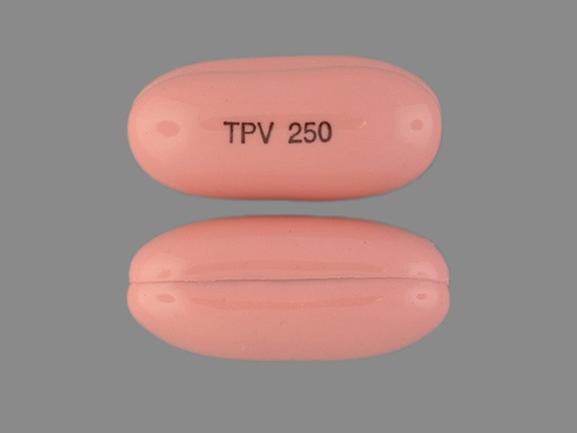Tipranavir and Alcohol/Food Interactions
There are 2 alcohol/food/lifestyle interactions with tipranavir.
Tipranavir Food/Lifestyle
Moderate Food Interaction
ADJUST DOSING INTERVAL: Food does not appear to substantially alter the pharmacokinetics of tipranavir. When tipranavir capsules or oral solution was coadministered with ritonavir capsules at steady-state, no clinically significant changes in tipranavir peak plasma concentration (Cmax) and systemic exposure (AUC) were observed under fed conditions (500 to 682 kcal, 23% to 25% calories from fat) relative to fasted conditions. The effect of food on tipranavir exposure during coadministration with ritonavir tablets has not been evaluated. High-fat foods may enhance the gastrointestinal absorption of tipranavir. In a multiple-dose study, administration of tipranavir capsules with a high-fat meal (868 kcal, 53% from fat, 31% from carbohydrates) increased the oral bioavailability of tipranavir by 31% compared to administration with toast and skimmed milk, but did not significantly affect tipranavir Cmax. Thus, tipranavir may be safely taken with standard or high-fat meals.
MANAGEMENT: Tipranavir coadministered with low-dose ritonavir should be taken with food to improve the gastrointestinal tolerability of ritonavir. According to the product labeling, tipranavir coadministered with ritonavir capsules or solution can be taken with or without meals, whereas tipranavir coadministered with ritonavir tablets must be taken with meals.
References (4)
- (2005) "Product Information. Aptivus (tipranavir)." Boehringer-Ingelheim
- Cerner Multum, Inc. "UK Summary of Product Characteristics."
- Canadian Pharmacists Association (2006) e-CPS. http://www.pharmacists.ca/function/Subscriptions/ecps.cfm?link=eCPS_quikLink
- Cerner Multum, Inc. "Australian Product Information."
Switch to consumer interaction data
Tipranavir High Cholesterol (Hyperlipoproteinemia, Hypertriglyceridemia, Sitosterolemia)
Moderate Potential Hazard, Moderate plausibility
PIs - hyperlipidemia
Treatment with ritonavir alone or in combination with other protease inhibitors (e.g., lopinavir, saquinavir, tipranavir, fosamprenavir) has resulted in substantial increases in the concentration of total cholesterol and triglycerides. These effects have also been reported with other protease inhibitors but may be the most dramatic with ritonavir. The clinical significance of these elevations is unclear. Marked elevation in triglyceride levels is a risk factor for development of pancreatitis. Triglyceride and cholesterol testing is recommended before starting ritonavir (with or without other protease inhibitors) and periodically during therapy. Lipid disorders should be managed as clinically appropriate.
References (6)
- (2022) "Product Information. Norvir (ritonavir)." AbbVie US LLC, SUPPL-25
- (2020) "Product Information. Reyataz (atazanavir)." Bristol-Myers Squibb, SUPPL-44
- (2019) "Product Information. Lexiva (fosamprenavir)." ViiV Healthcare, SUPPL-41
- (2020) "Product Information. Kaletra (lopinavir-ritonavir)." AbbVie US LLC, SUPPL-54
- (2020) "Product Information. Invirase (saquinavir)." Roche Laboratories, SUPPL-25
- (2020) "Product Information. Aptivus (tipranavir)." Boehringer Ingelheim, SUPPL-21
Switch to consumer interaction data
Tipranavir drug interactions
There are 404 drug interactions with tipranavir.
Tipranavir disease interactions
There are 4 disease interactions with tipranavir which include:
More about tipranavir
- tipranavir consumer information
- Check interactions
- Compare alternatives
- Side effects
- Dosage information
- During pregnancy
- Drug class: protease inhibitors
- Breastfeeding
- En español
Related treatment guides
Drug Interaction Classification
| Highly clinically significant. Avoid combinations; the risk of the interaction outweighs the benefit. | |
| Moderately clinically significant. Usually avoid combinations; use it only under special circumstances. | |
| Minimally clinically significant. Minimize risk; assess risk and consider an alternative drug, take steps to circumvent the interaction risk and/or institute a monitoring plan. | |
| No interaction information available. |
See also:
Further information
Always consult your healthcare provider to ensure the information displayed on this page applies to your personal circumstances.


